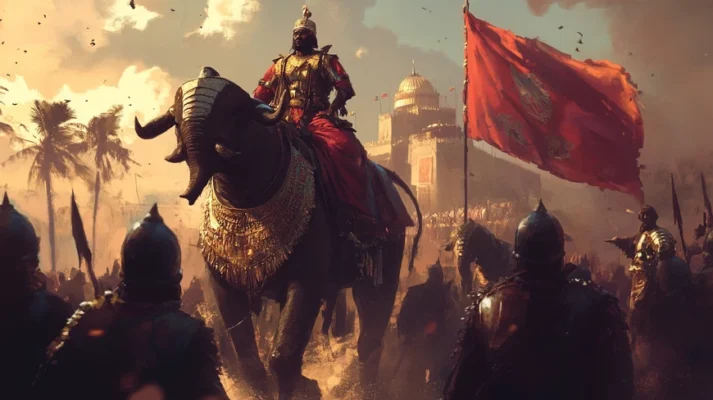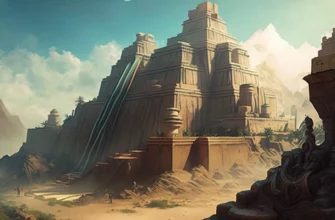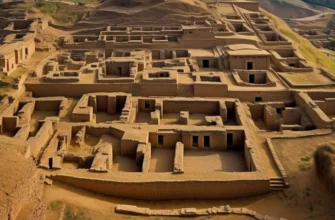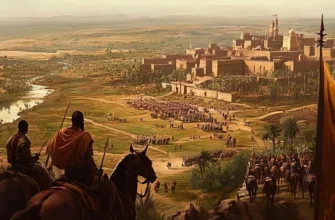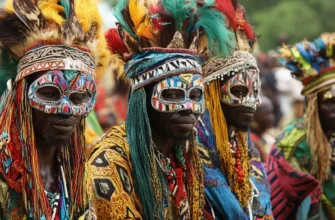The Kanem-Born Empire was one of the greatest states in Central Africa, existing from the 9th to the 19th century. It was located in what is now Chad, Nigeria, Cameroon, Niger, and Libya. The state of Kanem was formed in the 9th century in the northeast of modern Chad, and its foundation was laid by the Seifu dynasty, which ruled for over a thousand years.
In the 13th century, the empire reached its peak under the leadership of Maya Dunam Dibalam, a powerful ruler who expanded its territory and introduced Islam as the state religion. Kanem-Bornu was the center of trans-Saharan trade, through which caravans carrying salt, gold, fabrics, and slaves passed.
The state had a well-organized military system and a developed administration, which contributed to its long existence. In the 17th century, the empire began to weaken due to external attacks and internal conflicts. The final decline of Kanem-Bornu came in the 19th century, when its lands fell under the influence of colonial powers.
Although the empire ceased to exist, its cultural and political influence remained in many countries of West and Central Africa. Modern states such as Chad and Nigeria preserve the memory of this powerful empire, and the Seifu dynasty has become a symbol of African heritage.
- History
- Early state formations
- Foundation of the Kanem Empire
- Heyday and power
- The Seifu Dynasty
- Military power and conquests
- Political structure and administration
- Economy and culture
- Trade and crafts
- The influence of Islam
- Architecture and art
- The influence of Islam on art
- Decline of the empire
- Decline
- Military conflicts and invasions
- Conflicts with neighboring states
- After Islamization
- Attacks and invasions during the decline
- Loss of territory and weakening of power
- Final collapse
- The legacy of Kanem-Bornu
- Religious heritage
- Political legacy
- Conclusion
History
The Kanem-Born Empire emerged in the 9th century in the region of modern Chad. It was founded by the Seifu dynasty, which ruled for over a thousand years. Initially, the state of Kanem was a small tribal entity that gradually strengthened through military conquests and the development of trade.
In the 10th–11th centuries, Kanem became a powerful state, expanding its territories to the west and south. Contacts with Muslim merchants played an important role in the formation of the empire, contributing to the spread of Islam among the local nobility.
The empire’s golden age came in the 13th century during the reign of Maya Dunam Dibalam, who significantly expanded its borders by conquering neighbouring peoples. It was during this period that Islam became the state religion, strengthening the administrative and political system of Kanem-Bornu.
Early state formations
Before the emergence of the Kanem-Born Empire in Central Africa, there were numerous early state formations that became the basis for its formation. In the 7th–9th centuries, various tribes, including the Tubu, Kanuri, and other peoples, lived in what is now Chad, Nigeria, and Cameroon, leading a nomadic or semi-nomadic lifestyle. They gradually united into more organized political structures, which contributed to the development of local rulers and military leaders.
One of the first known state formations in this region was the Kingdom of Za, which had close contacts with North African traders. Thanks to the caravan trade between the Sahara and Sudan, cultural and economic exchanges took place, contributing to the development of the future empire. Gradually, one of these state formations, Kanem, began to dominate the neighboring territories, laying the foundation for the future great state of Kanem-Bornu.
Foundation of the Kanem Empire
The Kanem Empire was founded in the 9th century on the territory of modern Chad. Its creation is associated with the Seifu dynasty, which descended from the nomadic Tubu peoples. Thanks to its favourable geographical location near Lake Chad, the state was able to control important trade routes connecting North Africa with the regions south of the Sahara.
The first rulers of Kanem expanded their possessions through military campaigns, conquering neighbouring tribes and uniting them under a single authority. Trade in gold, salt, fabrics and slaves played a key role in the development of the state. In the 11th century, the rulers of Kanem converted to Islam, which helped strengthen political ties with the Muslim world, particularly North Africa and the Middle East.
Thus, Kanem became a centralized state with a developed administration, laying the foundation for the empire’s further prosperity in the following centuries.
Heyday and power
The Kanem Empire reached its peak in the 13th–14th centuries during the reign of Maya Dunam Dibalam (1221–1259). He significantly expanded the territory of the state, subjugating neighbouring peoples and establishing control over important trade routes connecting North Africa with regions south of the Sahara.
Kanem became a powerful state with centralized authority and an efficient administration. Islam, which the rulers of the Seifu dynasty adopted in the 11th century, became the state religion, which contributed to closer ties with Muslim countries, particularly Egypt and the Maghreb states. Kanem maintained diplomatic and trade relations with the caliphates of North Africa and sent pilgrims and ambassadors to Mecca.
The empire’s economy was based on trans-Saharan trade, whose main commodities were salt, gold, textiles, and slaves. The state had a powerful army, which included a well-organized cavalry. Thanks to its military strength, Kanem controlled large territories, but constant wars with neighboring peoples, particularly the Hausa and Tuaregs, gradually depleted its resources.
In the 14th century, Kanem began to weaken due to internal strife and external attacks. In the 15th century, the capital was moved west to the Bornu region, marking a new stage in the empire’s history with the creation of the Bornu state, which later inherited the political and cultural legacy of Kanem.
The Seifu Dynasty
The Seifu dynasty was the ruling dynasty of the Kanem-Bornu Empire, which ruled the state for over a thousand years, from the 9th to the 19th centuries. It is one of the longest-ruling dynasties in African history. Seif ibn Di Yasin is considered the founder, who laid the foundations of the future Kanem Empire in the 9th century.
The Seifu established their power through military force, a developed administrative system, and control over trans-Saharan trade. In the 11th century, the rulers of the dynasty converted to Islam, which helped strengthen ties with Muslim states in North Africa and the Middle East.
The most famous ruler of the dynasty was Mayi Dunama Dibalam (1221–1259), who expanded the territory of Kanem by conquering new lands and strengthening the state’s political influence. However, in the 14th century, internal conflicts and external pressure caused the empire to weaken.
In the 15th century, the dynasty moved its capital to the Bornu region, which marked the beginning of a new phase – the Bornu Empire. It preserved the traditions of Kanem and continued to exist until the 19th century, when it finally lost its independence under pressure from European colonizers.
Military power and conquests
The Kanem-Bornu Empire was one of the most powerful states in Central Africa thanks to its military strength and conquests. The Kanem-Bornu army consisted mainly of cavalry, which was well organized and equipped. Warriors used swords, spears, bows, as well as armor and protective shields, which gave them an advantage in battle.
The empire achieved its greatest conquests during the reign of Maya Dunam Dibalam (1221–1259), who significantly expanded the territory of Kanem. His military campaigns allowed him to establish control over the neighboring Hausa, Tubu, and Tuareg peoples. The conquered territories paid tribute, which strengthened the state’s economy.
The empire also actively used a professional guard consisting of slave warriors loyal to the ruler. This ensured the stability of power and reduced the influence of the local nobility.
Despite its military might, Kanem-Bornu constantly had to repel attacks from external enemies. In the 14th century, strong pressure from nomadic peoples led to the weakening of the empire, and the capital had to be moved from Kanem to Bornu. However, thanks to its military strategy and the mobility of its army, the state was able to maintain its position and even restore its power in later centuries.
Political structure and administration
The political structure and administration of the Kanem-Bornu Empire were well organized, with a clear division of powers and a centralized system of government. The state was organized around a system in which the ruler, the Maje, held supreme power. The Maje was an absolute monarch with unlimited power over all aspects of life, from military affairs to religious matters. Usually, upon the death of the ruler, his place was taken by his eldest son or the most experienced member of the royal family.
The Maya ruled through his council (the “Majlis”), which included important officials, such as senior army commanders, judges, and advisors from other important areas. However, unlike many European monarchies of the time, the role of the council in Kanem was quite limited, and the Maya still had the final say.
The state apparatus included numerous feudal structures and local rulers who controlled certain territories. These rulers, or shahis, gained control over territories in exchange for their loyalty to the Maiya, which allowed for the effective management of a large territory. They collected taxes, maintained armies, and performed administrative functions at the local level.
Religion also played an important role in the political system. After converting to Islam, the rulers of Kanem began to pursue policies aimed at integrating Islamic norms into administrative practice. Islamic judges (qadis) were an important part of the empire’s legal system, responsible for resolving disputes and enforcing religious precepts.
Thanks to this centralized political structure and close cooperation between the military and religious authorities, the Kanem-Bornu Empire was able to effectively govern large territories and successfully resist external threats.
Economy and culture
The economy of the Kanem-Born Empire was heavily dependent on trans-Saharan trade, which provided the state with significant profits and contributed to its prosperity. Kanem-Born was located on important trade routes connecting the Sahara with other parts of Africa and the Muslim world. Traders brought salt, gold, fabrics, as well as livestock, slaves, and exotic goods to the empire. In exchange for these resources, Kanem-Bornu exported salt, leather, gold and silver jewelry, and other goods that were in demand in North Africa and the Middle East.
Thanks to these trade routes, the Kanem-Born Empire was economically strong and had a significant influence on the region. Developed agricultural activities, including the cultivation of rice, wheat, and corn, as well as cattle breeding, made it possible to meet food needs and create surplus stocks for trade.
The culture of Kanem-Bornu was greatly influenced by Islam, especially after the rulers of the Seifu dynasty converted to Islam in the 11th century. This not only changed the religious landscape of the empire, but also introduced new elements into cultural life. Muslim scholars, lawyers, and theologians actively influenced the development of education, and madrasas (Islamic educational institutions) began to appear in cities, where young people from different parts of the empire and even from neighboring lands studied.
Architecture also flourished, as Islamic architectural traditions influenced the construction of mosques, palaces, and other important buildings. Although the greatest architectural boom occurred during the Bornu period, the Kanem Empire left a cultural legacy that reflected the fusion of traditional African and Muslim elements.
In addition, the art of Kanem-Bornu was also of a high standard. Crafts such as weaving, metalworking, woodcarving, and leatherworking were well known. Particular attention was paid to the creation of jewelry, especially gold and silver, which often had ritual or symbolic significance.
The cultural and economic activities of Kanem-Born made this empire an important center of African civilization, influencing the development of other states in the Sahara and Central Africa.
Trade and crafts
Trade and crafts were important components of the Kanem-Born Empire’s economy, contributing to its prosperity and power for centuries.
Trade in Kanem-Bornu was closely linked to transatlantic and trans-Saharan routes, through which the empire controlled the main trade routes between North Africa, West Africa, and the Sahara. One of the main commodities that circulated through the empire was salt, which was vital for the inhabitants of the Sahara and surrounding areas. Kanem-Bornu also exported gold mined in local mines, as well as slaves and hides, which were important trade goods. For its part, the empire imported fabrics, jewelry, alcoholic beverages, and other goods from North Africa and the Middle East.
In addition, caravan trade played an important role in the empire’s trade network, with large trade caravans crossing the Sahara, delivering goods through the territories of Kanem-Bornu. During such journeys, the cities of the empire became important trading hubs, where merchants from all over the world gathered.
Crafts in Kanem-Bornu were also well developed. Local craftsmen were engaged in metalworking, the production of gold and silver jewelry, fabrics, leather, and other products. The manufacture of copper products and cast iron ingots, which were used for trade or as currency, was also well known.
Pottery, hand-woven fabrics, and wooden products were in demand both in Kanem-Bornu itself and in other regions that actively interacted with the empire through trade.
Thanks to the development of crafts and the flourishing trade, the Kanem-Born Empire became a powerful economic and cultural center that had a great influence on the Sahara and Central Africa.
The influence of Islam
The influence of Islam on the Kanem-Born Empire was significant and profound, especially after the rulers of the Seifu dynasty converted to Islam in the 11th century. This was a turning point in the history of Kanem-Born, as religion not only changed the spiritual life of the empire, but also had a significant impact on politics, culture, and the economy.
Religious influence:
After converting to Islam, the rulers of Kanem-Born became followers of the Muslim faith, which contributed to the development of Islamic culture and education in the state. The Islamic worldview, including religious rituals and precepts, influenced political and social life.
The introduction of Islamic norms into legislation became the basis for the creation of a legal system, particularly through Sharia law. Islam became the state religion and also determined the behavior of rulers, which helped stabilize the political situation in the empire.
Educational influence:
Islam contributed to the development of education in Kanem-Bornu. Muslim scholars and theologians introduced Islamic education by opening madrasas (Islamic educational institutions). The study of Arabic became an important element of culture, as Arabic was the language of religious texts and scientific works.
Madrasas taught not only religion but also various sciences, including mathematics, astronomy, and history, which contributed to the development of the empire’s intellectual potential.
Cultural influence:
Islam had a great influence on the architecture and art of Kanem-Bornu. The construction of mosques, palaces, and other important buildings in the empire began to follow Islamic architectural traditions.
Mosques, as religious and cultural centers, became important elements in the cities and towns of Kanem-Bornu. Muslim artists and craftsmen introduced new techniques and styles to decorative arts, including jewelry making, ceramics, and textiles.
Political influence:
Islam also promoted the development of diplomatic relations with other Muslim states, particularly Egypt, the Maghreb, and the Caliphates in the Middle East.
This strengthened Kanem-Bornu’s international status and opened up new opportunities for trade and cultural exchange. Islam helped Kanem-Bornu integrate into the wider political and economic network of the Muslim world.
Economic influence:
Islam also had an impact on economic relations, as many trade routes passed through Muslim territories. Trade with North Africa and the Middle East flourished thanks to Islamic trading traditions, which opened up new markets for Kanem-Born products, including gold, leather, and slaves.
Thanks to all these aspects, Islam became an important part of Kanem-Bornu’s identity, contributing to its development and prosperity over the centuries.
Architecture and art
The architecture and art of the Kanem-Born Empire reflected its wealth, cultural influences, and religious transformations, particularly after the adoption of Islam.
Architecture
The architecture of Kanem-Bornu was mixed, reflecting a combination of traditional African styles and Muslim influences. After the adoption of Islam in the 11th century, the architecture of the empire began to change, and elements of Islamic style appeared.
Mosques became important architectural elements in Kanem-Bornu. They had features characteristic of Islam: flat roofs, minarets, and round domes. The construction of mosques became not only a religious but also a social act, as they were often centers of cultural and scientific life.
One of the most famous architectural monuments of that time is the mosque in Djenné (a later addition to the architecture, but similar structures existed in Kanem), which became a symbol of African Islamic architecture. However, traditional African elements were also preserved in Kanem-Bornu, including the construction of palaces for rulers, grain stores, and fortifications that helped defend the territory from enemy attacks.
Art
The art of Kanem-Bornu was distinguished by a high level of craftsmanship and decorative arts, particularly in metallurgy, woodworking, ceramics, and textiles. Local craftsmen produced gold and silver jewelry, cast iron ingots, and wood and leather products.
Thanks to the influence of Islam, new elements appeared in art: calligraphy in Arabic letters, as well as decorative motifs on fabrics and ceramics depicting geometric figures and abstract ornaments. After the adoption of Islam, a period of development began in book printing and the production of manuscripts with religious texts, in particular the Koran.
Fabrics and leather goods were popular in Kanem-Bornu. Local materials were used not only to make clothing and household items, but also objects for religious ceremonies that contained religious and cultural symbols.
The influence of Islam on art
Islam also brought to the art of Kanem-Bornu the tradition of making jewelry and religious objects. Arabic calligraphy and religious symbols became popular, particularly in the production of miniatures for religious books, as well as in decorations for mosques and palaces.
The art of ceramics, metalwork, and leatherwork became more refined thanks to the influence of Islamic aesthetics and crafts brought by Muslim merchants and craftsmen.
The architecture and art of Kanem-Bornu became an important part of the cultural heritage, combining African traditions and Islamic influences. This synthesis of cultures and religions contributed to the development of the state and its artistic tradition, leaving a significant mark on the history of West and Central Africa.
Decline of the empire
The decline of the Kanem-Born Empire was the result of a number of internal and external factors that led to its gradual weakening and loss of power in the late Middle Ages and early modern period.
Internal factors
Political instability:
In the 14th and 15th centuries, the empire experienced periods of political turmoil due to internal conflicts. The rulers of Kanem-Bornu often fought for power, leading to noble unrest and a decline in centralized authority. The power of the Seifu dynasty began to weaken, and control over various regions of the empire became less effective.
Social and economic problems:
Excessive taxation of the population, as well as dependence on foreign trade and resources, contributed to the weakening of the economy. In addition, constant wars and unrest affected agricultural production and overall stability in the empire.
External factors
Attacks by nomadic peoples:
In the 14th century, the empire was attacked by nomadic peoples such as the Tuaregs and Seljuks, who raided the territory of Kanem-Bornu. External pressure contributed to the weakening of an already unstable political situation.
Turkey and colonization:
In the 16th century, new threats to the empire emerged. As Kanem-Born was an important link in the trans-Saharan trade, it fell under the influence of Muslim states in the north, which weakened its autonomy. European colonizers, who began to penetrate West Africa, also posed an additional threat to the empire.
Loss of control over trade routes:
Changes in international trade, including the growth of maritime trade across the Atlantic Ocean, reduced the importance of land trade routes through Kanem-Bornu. This significantly reduced the empire’s economic power, as most of its income came from transatlantic trade.
Decline
Finally, in the 19th century, the Kanem-Born Empire finally lost its independence. In 1893, the empire’s territories were conquered by Britain and France, which divided the African lands between themselves. This put an end to Kanem-Bornu’s existence as an independent state. Only its glorious days as one of the largest and most influential empires in West Africa remain in history.
Military conflicts and invasions
Military conflicts and invasions were an important part of the history of the Kanem-Born Empire, and they played a significant role in its growth, stability, and decline.
The Kanem Empire was founded amid constant conflicts with neighboring tribes and states. The Kanem-Born military organization was one of the strongest in Africa, and its army was actively used to expand the empire’s territory and maintain power in the region. Kanem-Born troops often fought against the Tuareg, Berbers, and other tribes who sought to gain control of important trade routes or territories.
Military campaigns during the reign of the Seifu dynasty
The founding of the Seifu dynasty in Kanem in the 11th century laid the foundation for the empire’s significant growth in territory and power. During this period, there were numerous military conflicts as the empire expanded its borders to western Chad and adjacent territories. Military campaigns focused on fighting neighbouring peoples, particularly the military forces of Mali, as well as repelling attacks from other African states.
The Kanem-Born Empire was also known for its strong cavalry, which used horsemen to fight battles, a significant advantage over the infantry of most other African peoples.
Conflicts with neighboring states
Over the centuries, Kanem-Bornu often had to wage war with neighboring states and peoples. Here are some notable conflicts:
Conflicts with the Mali Empire:
In the 13th century, the Mali Empire attempted to expand its influence into territories belonging to Kanem-Bornu.
This led to a series of military clashes between the two powerful states. Although Kanem managed to defend its independence, the conflicts with Mali were one of the most important challenges for the empire.
War with Khadja:
In the mid-13th century, a major military clash took place with Khadja, who was trying to seize the territories of Kanem-Bornu. This was an important moment in history, as these conflicts helped to consolidate Kanem-Bornu as a powerful force in the Sahara region.
Conflicts with nomadic peoples:
Kanem-Bornu also had to fight constantly against nomadic Tuaregs and other tribes who raided the empire’s territory. The Kanem-Bornu army had extensive experience in wars with nomadic peoples, so over time they maintained control over their territories, although the losses were significant.
After Islamization
After the Kanem-Born Empire converted to Islam in the 11th century, it gradually became part of the Islamic world. However, this also meant that the empire began to suffer attacks from northern Muslim states seeking to expand their territory and influence across the Sahara.
At this time, Kanem-Bornu also faced attacks from other Muslim states, including the Seljuks and Maghreb rulers.
Attacks and invasions during the decline
With the weakening of central authority in the 16th and 17th centuries, the Kanem-Born Empire fell victim to numerous attacks and invasions by external forces.
Attacks from Bornu:
During this period, Kanem-Bornu was attacked by Bornu, which was one of the reasons for the empire’s collapse. Bornu, which had previously been part of Kanem-Bornu, began to conquer territories and eventually replaced Kanem as the empire’s main center.
European intervention:
From the end of the 17th century, when European colonial powers, notably France and Britain, began to penetrate West African territories, new external threats began to weigh on the Kanem-Bornu Empire. Their colonial expansion contributed to the final decline and collapse of the empire.
Military conflicts and foreign invasions in the history of the Kanem-Born Empire were the main factors that contributed to its expansion, but also to its decline. Constant wars, interventions by neighbouring peoples and states, and the influence of European colonisers weakened the empire and ultimately led to its downfall.
Loss of territory and weakening of power
The loss of territory and weakening of power were key factors that contributed to the decline and eventual fall of the Kanem-Born Empire. These processes took place over several centuries and were critical to the stability of the empire.
Loss of territory
The attack on Kanem by Bornu: In the mid-16th century, the Kanem Empire began to suffer significant territorial losses. One of the main reasons was the invasion by Bornu, a region located southwest of Kanem. Bornu was originally part of Kanem-Bornu, but over time began to claim independence. As a result of military conflicts and internal divisions, Bornu finally captured important territories of Kanem, and in the middle of the 16th century, the center of the empire moved to Bornu. This process effectively reduced the size and political power of Kanem-Bornu, as most of the territory came under the control of Bornu.
Loss of territory due to attacks by neighbouring peoples: Due to its relative weakness after losing part of its territory, the Kanem-Bornu Empire began to suffer attacks from neighbouring nomadic tribes such as the Tuaregs and Seljuks. This weakened control over important trade routes and strategic territories, which affected the empire’s economic potential.
External influences and European expansion: With the arrival of European colonizers in West Africa in the 16th-18th centuries, the Kanem-Born Empire lost important trade routes and markets. Europeans actively penetrated Africa, weakening the empire’s influence over its neighboring territories. This also led to a further reduction in the lands that Kanem-Bornu could control.
Weakening of power
Political instability: During the late Middle Ages, Kanem-Bornu suffered from internal political instability. Disputes over power often arose between different members of the ruling Seifu dynasty. Internal conflicts led to changes in leadership, creating a power vacuum and destabilizing the empire. Weak rulers were unable to effectively govern the vast territory, further contributing to the weakening of centralized power.
The collapse of the administrative structure: Due to frequent internal conflicts and territorial losses, the Kanem-Born Empire began to suffer from the weakening of its administrative structure. Local rulers gained more and more autonomy, leading to fragmentation of power and the inability to effectively govern a vast territory. This weakened the empire’s ability to resist external threats and maintain order within its territory.
Religious changes and conflicts: The adoption of Islam in Kanem-Bornu in the 11th century initially contributed to the strengthening of the empire, but over time, religious differences and varying approaches to Islamic norms caused tensions between the ruling elites and local populations. Islamic influences from the north and traditional African religions often clashed, leading to religious conflicts and instability within the state.
Growing external pressure: After a period of prosperity, the Kanem-Born Empire faced enormous external pressure from nomadic peoples such as the Tuaregs, as well as the growing expansion of European colonial powers. They began to actively interfere in the political and economic processes in Africa, which forced the Kanem-Born Empire not only to lose important territories but also to weaken its ability to fight new threats.
The loss of territory and the weakening of power were the main factors that led to the decline of the Kanem-Born Empire. Political instability, internal conflicts, external conquests, and new socio-economic changes significantly reduced its former power. Over time, the empire lost its ability to effectively govern its territories, which led to its collapse and decline in the 19th century.
Final collapse
The final collapse of the Kanem-Born Empire occurred in the 19th century, and this process was the result of several interrelated factors, including both internal conflicts and external threats, in particular the invasion of new forces and colonial expansion.
Internal problems and weakening
Political instability:
At the beginning of the 19th century, the Kanem-Born Empire was weakened by constant internal conflicts for power, as well as struggles between different branches of the Seifu dynasty. This led to the weakening of central authority and the partial fragmentation of the empire. Local rulers gained increasing autonomy, which contributed to internal disintegration.
Social and economic difficulties:
The loss of major trade routes through the Sahara, as well as declining economic stability, contributed to internal crises. The once-prosperous trade networks that passed through Kanem-Bornu were replaced by new sea routes. This led to economic decline and increased social tensions within the empire.
External threats
Attacks by neighboring peoples:
The Kanem-Born Empire was constantly attacked by neighboring tribes and states, including the Tuaregs, Seljuks, and Fulani. In the mid-19th century, these peoples became more aggressive, and as a result, Kanem-Born began to lose important territories. The attacks weakened the state and reduced its ability to defend itself.
Colonial expansion by Europeans:
In the mid-19th century, European colonial powers, particularly France and Britain, began to actively expand their influence in Africa. The Kanem-Born Empire, already experiencing internal difficulties, was unable to effectively resist the colonizers. The British and French gradually seized territories that had previously belonged to Kanem-Bornu, increasing pressure on the empire.
Islamic conquests and internal conflicts:
The loss of political stability as a result of the struggle between Islamic and traditional rulers also contributed to the weakening of the state. Islamic movements, which already had a significant influence, conflicted with local traditions and religions, leading to social unrest and changes in the political structure.
Final collapse
Attacks by the Bornu Empire:
In the early 19th century, the Bornu Empire, which had been part of Kanem-Bornu in the past, began to actively expand its territory at the expense of Kanem-Bornu. Bornu successfully captured important strategic points in the south-west of Kanem-Bornu, leading to the effective collapse of this part of the empire. This was another important stage in the collapse of Kanem-Bornu as a single state.
Conquest by the French and British:
In the mid-19th century, French and British colonial forces began to intervene more actively in the political processes of West Africa. Britain, having seized territories in the southwest, and France in the north, finally broke up the remnants of the empire’s political integrity. As a result, Kanem-Bornu was divided between the colonial powers.
Mid-19th century – the end of Kanem-Bornu:
In the mid-1800s, the Kanem-Born Empire effectively ceased to exist as an independent entity. In the absence of a strong central government and under the influence of colonial powers, the empire fell into decline. By the end of the 19th century, its territories had been partially annexed by French West Africa and British colonies.
The final collapse of the Kanem-Bornu Empire was the result of a combination of internal problems, military conflicts, attacks by neighboring peoples, and colonial expansion by European powers. The loss of territory, political instability, economic difficulties, and external threats contributed to the gradual decline of this great African state.
The legacy of Kanem-Bornu
The legacy of the Kanem-Bornu Empire is an important stage in the history of West Africa. Although the Kanem-Bornu Empire ceased to exist in the mid-19th century, its cultural, religious, and political influence remained significant for many years after its fall.
Impact on modern states
Impact on modern countries:
The territories that once belonged to the Kanem-Born Empire are now part of modern Chad, Niger, Nigeria, and Libya. The legacy of Kanem-Born is evident in the cultural traditions, languages, and religious practices of these regions. In particular, Chad and Nigeria have preserved the memory of the former empire, which was known for its political stability and strong military organization.
Cities and archaeological sites:
One of the important legacies of Kanem-Born is the archaeological sites and remains of ancient cities that can still be found in the region. The ruins of the ancient city of Ngazargamu, which was the capital of Kanem-Bornu at the height of its power, are evidence of the empire’s high level of architectural skill and urban traditions.
Cultural heritage
Language and literature:
The Bornu language (one of the ethnic groups of the Kanem-Bornu Empire) is still spoken in the region today, and the culture of writing that existed during the reign of Seifu has left its mark on local literature. Among the creative achievements of Kanem-Bornu are oral folk art, songs, and legends that have been passed down from generation to generation.
Architecture:
The heritage of Kanem-Bornu includes architectural traditions, especially in the construction of fortresses and palaces. These were practical in nature, designed to protect against attack, but were also noted for their sophistication and detail. The architectural styles of Kanem-Bornu influenced later cultures in this part of Africa.
Religious heritage
Islam:
One of the greatest legacies of the Kanem-Bornu Empire is Islam. The empire was one of the first in West Africa to adopt Islam, which became an important factor in its cultural development. Islamic traditions, religious institutions, and a legal system based on Islamic norms had a huge influence on subsequent African states.
Islamic education:
Kanem-Born had significant centers of Islamic education, where religious leaders, scholars, and rulers were trained. This became the basis for the further development of Islamic culture and science in the region and influenced education and religious practices in subsequent generations.
Political legacy
The Seifu Dynasty:
The political legacy of Kanem-Bornu was preserved through the Seifu Dynasty, which, although it lost its power by the end of the empire, remained an important symbol for future rulers of the region. Its traditions of governance and organization of military and civil authority served as an example for later African monarchies.
The idea of centralized power:
Kanem-Bornu is known for its centralized political structure, which ensured the stability and prosperity of the empire for a time. Its ideas of governance, based on unity and monarchical power, were adopted by other African states as a positive example of centralized administration.
The legacy of the Kanem-Born Empire remains an important part of Africa’s cultural and historical memory. Its influence can be traced in political structures, cultural practices, religious traditions, and architectural achievements. Despite the fall of the empire, its legacy continues to play an important role in shaping the identity of contemporary African peoples and states.
Conclusion
The Kanem-Born Empire left a deep and lasting mark on the history of West Africa. Its heyday, military power, economic development, and cultural achievements laid the foundation for the formation of subsequent African states and civilizations. The empire’s legacy is evident in the influence of Islam, architectural traditions, political structures, and religious practices that continue to be relevant today. Although the empire declined due to internal conflicts and external threats, its legacy continues to influence the culture, politics, and religion of the modern countries that occupy its former territories. The Kanem-Born Empire is an important part of African history and is significant for understanding the development of the region as a whole.
